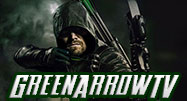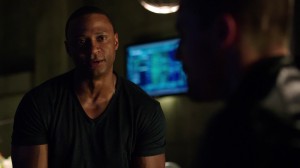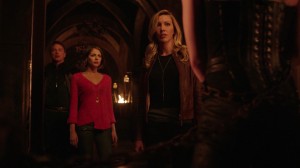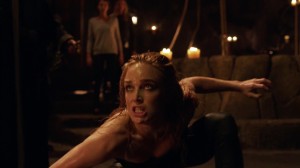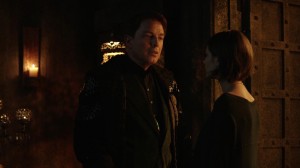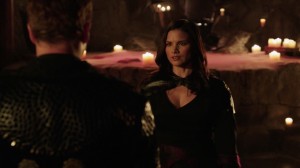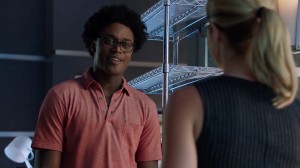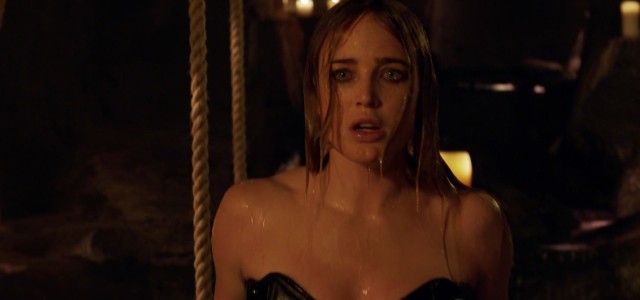

Arrow #4.3: “Restoration” Deep Review
Recaps & Reviews November 3, 2015 Matt Tucker

Summary: A serviceable theme episode featuring strong acting and presenting some tough moral questions.
If you have not seen this episode yet and do not wish to be spoiled, do not continue reading!
For a full episode synopsis, grab a read of our Quickshot Recap: #4.3: “Restoration”
Review
We’ve mentioned in the past how Arrow is fond of adopting a theme for a given episode now and then, tying not just the main plotline to it but plots B and C (and any other subplots). It’s not an uncommon storytelling device on television, but Arrow refrains from doing it on a regular basis and risk losing the effect. It’s not always handled adroitly — one need only look at last season’s “Guilty” to see how indelicate and unsubtle it can be at times — but the show usually does fine by it. “Restoration” is no exception.
In a way, that title and theme for the hour also reflects this season, the show having a creative and narrative resurgence after faltering last year. Two of the biggest lingering effects of last season come to a head and form the major framework for the episode, but restoration isn’t limited to just Oliver and Diggle or Sara Lance. The theme also touches daughter Thea and father Malcolm, as well as her struggles with a steadily devolving inhuman part of herself, and also informs the position Laurel’s actions put Nyssa in and her response. Even an aspect of the Felicity and Curtis Holt storyline grazes the theme in an indirect way.
Brothers in Harm…?
For all the talk of “Original Team Arrow” in the episode, it’s often easy to forget that everything started and evolved with just these two. Hired by Moira Queen as her son’s bodyguard, John Diggle was tasked as much with keeping an eye on Oliver as he was offering protection for him. His innate goodness and righteousness, as well as his skill set and the aggrieved sense of justice over his brother’s murder, are what drew Oliver to trust him with his secret and fight. As Oliver was a soul lost and singularly focused on his vigilante mission, Diggle’s moral compass provided direction for Oliver to find his humanity once again. No matter the people they’ve recruited into their cause or the varied relationships they’ve taken on, the connection between the two is the basis for the entire team. More, they became brothers, not just in arms but in friendship and chosen family.
Yet, there have been fissures in the foundation for a while that cracked to full-on fractures once Oliver made the choice to not tell any of the team he was working with Malcolm Merlyn to take down Ra’s al Ghul from inside the League of Assassins. Using Diggle’s family to sell his allegiance, Oliver’s bullheaded decision was a straw too far. Diggle makes a finer point about it, though. It was one thing to put his family in seeming danger, but that Oliver was capable — and willing — of making that choice, there is nothing governing that he won’t do it again. That rightly haunts Diggle, and while Oliver is fair to point out that John not giving him a chance to make it right is out of character, I think it speaks to the conflicts that have existed under the surface between the two for a while.
Diggle does give Oliver a chance by sharing with him his two-year investigation into H.I.V.E. That the importance of this for Diggle has always seemed to take a backseat to Oliver’s stuff, it does seem slightly strange to fully read him in on it. But Oliver is a agent of change, and if anything, John recognizes that Oliver can get things done when his attention is pointed towards it. It’s a practical decision, which offers some explanation as to why it seemed a bit quick for Diggle to offer an olive branch. It’s not really until Oliver takes Double Down’s card to the chest by stepping in front of it to protect John that he’s willing on a personal level to give his friend another shot at regaining his trust. A bit on-the-nose, but effective nonetheless.
Their confrontation, forced by Felicity, is a bit of a long scene in television terms, but seems brief given the import and the nature of the conflict. Yet, the show has frequently been at its best when it pairs Stephen Amell and David Ramsey to take its moral pulse. Reconnecting these two provides a better and stronger team. I don’t see this being the last time that conflict arises between the two, but it’s good to see them side-by-side again.
Sisters in Limbo
Though “resurrection” is more apropos, the theme of restoration doesn’t get more literal than bringing someone back to life. Nyssa puts Laurel’s urge in poignant context: this is about her grief more than her love. That’s not to discount her love and care for her sister, but her grief is clearly clouding her good judgment. It’s a very human thing, though, and certainly hard to slight her for the opportunity. To a person, you’d likely be hard-pressed to find anyone who wouldn’t attempt the same thing if it were available to them. A chance to bring a dear loved one back is a temptation too great, despite the moral implications. (Let’s not even go down the path of any obvious religious/spiritual questions raised.)
The show’s approach to the Lazarus Pit, which we’ll touch on more in a bit, is rather unique. The name itself is taken from the Judeo-Chrisitan Biblical story of Lazarus of Bethany, said to have been brought back to life four days after his death. The name’s become a pretty common shorthand when talking about resurrection, yet the Pit of the comic books was known primarily for restorative powers for the living. It could cure fatal wounds, but stories of bringing someone back to life with it are extremely rare. From that aspect, that they made this particular use archaic rumor on the show, let alone something roughly considered taboo, is fitting. They take their interpretation a step further by explaining that, when in the Pit, it takes some of a person’s lifeforce and and personality as it is rehabing them. This is what causes both the temporary insanity and gaps in memory, as each user is exposed to these lifeforces and personalities.
That makes for a relatively plausible conundrum when dealing with trying to bring someone back to life. If one no longer has lifeforce or a personality, it would be reasonable to assume that the water pours this mix of all the others into the body. So, Sara truly is this amalgamated beast, fueled by base impulses and conflicting voices in her head with nothing to bounce them off of and regain some structure. Sara the body lives but Sara the person still continues to no longer exist. It’s a rather disturbing thought, and you have to imagine that once Oliver finds out what the hell is going on, his inviting John Constantine to help will be a way to bring Sara’s soul back and tether it to her body. Until then, it’s heartbreaking to see Laurel try to reach out to her sister when she’s just not there. All she is right now is rage and confusion, which Laurel blindly sees past for her hope. That hope is admirable but Laurel seems to be building herself a fantasy rather than dealing with things as they are.
Bloodlines You Don’t Cross
It’s Thea’s experience that is strongly feeding into Laurel’s thought process. Obviously, something is not right with Thea, and here’s another way in which their interpretation of the Lazarus Pit takes on a life of its own. In the comics, the Pit’s waters were comprised of a number of natural chemicals in a primordial mix that only one person was able to recreate through modern science. Exposing someone to those chemicals drove them temporarily insane but the effects were never portrayed as lasting. That’s obviously not the case with Thea and Nyssa alluded to her father also continuing to experience its lingering effects. He frequently used the Pit, so maybe that counteracted the bloodlust. Then again, we just assumed that Ra’s al Ghul’s fights with members of the League were purely training with the unfortunately outcome that he would kill those who failed to defeat him. He could very well have been using that to deal with the bloodlust.
The one thing to be grateful for was that they didn’t simply solve Thea’s problem. There was a brief flirtation with that with Malcolm’s fake about a mystic who could remove the urges, which would’ve continued a bad pattern of cutting the legs of Thea’s stories out from under her. Thankfully, they used it to further Malcolm’s personality. He’s got the ultimate control he wanted, as well as his revenge on the previous Ra’s, but he’s always had this strange parental pull that’s informed a lot of what he does. It’s been six months since contact with Thea and he wants to reconnect, to restore that relationship. As a sociopath, though, it’s by his own unique and skewed set of rules. Only Malcolm would think that providing his daughter with fodder to abate the bloodlust every few weeks is appropriate and fun for the whole family. (To be fair to his point of view, while not condoning it in the slightest, something has to be done to curb these inescapable impulses in his daughter. She’s going to find it this way or continue to take it out on the people Team Arrow tracks down each week. Is there a lesser of two evils in this case?)
Despite how the League has been threaded into the fabric of the series itself, there didn’t seem to be a concrete way to really incorporate Malcolm into the continuing story this season. Even Nyssa was loosely connected by her relationship with Laurel, perhaps popping in from time to time to brush Black Canary up on her skills. And the use of the Lazarus Pit as the means to bring Sara back to set up her role in Legends of Tomorrow was always momentary. Basing his continued involvement on Thea’s story and trying to rebuild their familial bond is an organic fashion to keep him around, which of course offers plenty of opportunity for Malcolm and the League to act as thorns in Oliver’s side.
The Pit and the Punishment
Nyssa, meanwhile, is becoming a wildcard to both sides. It was always interesting that Malcolm welcomed her back into the League, though he probably considered it a sick reward for her part in taking down her father. That Nyssa came back seemed like an odd fit, aside from the fact that the League is the only life she’s known. That she openly threatens Malcolm while concurrently recognizing his position as the Demon’s Head makes for a solid position to tell compelling stories of those competing thoughts. Or it would if they didn’t barrel right past that to her outright defiance and Malcolm’s subsequent punishment.
The Pit was always going to be an odd sticking point in the series. The questions raised by them bringing Sara back from the dead made for too much potential to kill permanent consequence on the series. If not just wounds but death itself could be beaten back, especially if they were/are to solve the issue of reintegrating Sara’s soul into her body, then what’s to stop them from bringing everyone back: Tommy, Moira, Shado, even Robert Queen, Nora Allen, and Malcolm Merlyn’s wife. In the comics, there were a number of pits around the world before Batman and usual villain Bane went around and destroyed all but one that existed in the Batcave. Though, it was revealed there were four others that Bats and Bane didn’t know about. The show seems to play at the idea that this is the one and only Pit in the DCwU world, so the shortcut had to be addressed, especially as they set up the grave mystery flash-forward in the season premiere.
With so many outside forces posing threat, it makes all the sense in the world that Ra’s al Ghul would develop some kind of counteragent to the Pit. That’s just not one of those things you leave the keys lying out over. And going into the episode with the knowledge that they were going to “solve” the outstanding issue of the Pit, there was some expectation that it would become sealed or closed off in some fashion. Or perhaps, even drained. Still, turning it into the hot tub of poison was a bit surprising as the method, and using Nyssa as the catalyst was a canny choice.
Not only does this exacerbate the friction between Nyssa and Malcolm but it also sets her at odds with Laurel, which could be a fascinating development depending on how long Nyssa is locked in the Nanda Parbat dungeon. With her pre-existing disdain for Oliver, a searing hatred of Laurel could spell significant trouble for the team down the road.
Card Tricks
Current trouble for the team resides with Damien Darhk and his shadowy organization. The structure of H.I.V.E. is more interesting than originally thought. Given the set-up last season with Darhk many years prior having left the League of Assassins after he wasn’t chosen as Ra’s al Ghul, there was the implication that Darhk had formed his own association. That could potentially still be the case, but with him having partners and them employing Mina Fayad to see to their interests, one gets the feeling that H.I.V.E. existed before Darhk. It would be wrong to think he’s an employee of the clandestine group, but as a vested partner, he’s clearly seen as a fringe element. From what we’ve gotten to know of Darhk, he wouldn’t have it any other way, and he revels in being thought of as a freaky outsider.
It was genuinely unanticipated that they would be addressing the woman from Floyd Lawton’s flashbacks in last season’s “Suicidal Tendencies” so quickly. Even more so that they’d dispatch her just as quick. Miss Fayad, we hardly knew ye. The implication of jumping right into her involvement was that Diggle’s long-sought answers would be gained in far shorter order than any of us could have expected. Leave it to Arrow to both burn through plot but also throw a curve in such a fashion to keep the mystery alive. You couldn’t say the mystery was deepened, but it revealed a number of interesting things about H.I.V.E. The seeming antagonistic relationship between Darhk and other members of the group is one, but that they empowered Fayad to go out and hire Jeremy Tell to accomplish their goal suggests that they are open to exploiting the existence of metahumans. Though, it can certainly be argued that they just gave Fayad the freedom to get the job done and it was her independent choice to seek out the organic playing card throwing goon. After all, they dismissed tell of Darhk’s mystical abilities as “parlor tricks,” so maybe they are less inclined to go in on the supernatural and superhuman elements of the world. More important, Darhk taking Fayad out adds the appropriate ominous weight to the whole affair; if she was such a key to Diggle finding out why his brother was killed, then Darhk and the currently faceless other members of H.I.V.E. are far more vital and dangerous. That’s not even touching on the mysterious Phase 3 of the “Genesis” project that Darhk and Fayad referenced.
Less vital, Tell proves another of those interesting but ultimately disposable one-week villains. The show is being careful in their use of metahumans to not take anything away from The Flash but all the same exhibit that this is a problem that lives in their collective world now. His ability proves a fun tweak on the hired gun concept, and they also get the opportunity to play with a common trope of the bad guy tracking the goodies back to their base of operations. It felt like a natural way to incorporate Curtis Holt into the story, as well as introduce him to Felicity’s work with the Green Arrow. Though, it still makes little sense how Double Down got into the team’s base and managed to bound down the building in step with the elevator to catch the two. In the end, Tell is relatively easily taken down, and while guest JR Bourne gives him some character, there’s just very little to warrant any follow-up with him down the line.
Curtis is proving to be a great resource for technical aspects that are beyond Felicity’s capability (a seeming correction for a gripe we’ve expressed in the past) and a companion and confidante for her. He should bear out to be instrumental in helping Felicity locate and save Ray Palmer. Though they never get explicit with why it’s happening, they make the effort to point out on a couple of occasions that Felicity’s phone flips out when she’s in the Palmer Tech lab, the last time going so far as to spell her name out in the garbled mess on the phone. Those kinds of context clues suggest that Ray has been reduced to microscopic or, perhaps, even sub-microscopic level and has been surviving within the lab for the whole of the last 6-7 months. Only now has he had the ability and opportunity to try to reach out to Felicity for help. That brings us round to our last touch on the theme of restoration, and it’ll be fascinating to see how long it takes Felicity or Curtis or both to put the pieces together and free Ray from a rather unique nightmare of a life.
Conclusion
As a theme episode, “Restoration” is one of the better ones to involve nearly all of its story threads in the theme. (One can’t say that the flashbacks fit neatly into the theme, but we’ll get into the past storyline at another time.) Though there is a hint of convenience, some resolution to the Oliver-Diggle conflict that allows the two to work together and trust each other again is not only welcome but essential to the team working at its best level. Laurel’s somewhat misplaced hope over her sister’s return borders on being as disturbing as the fact that they’ve brought Sara back to life, if not even more. Nyssa is right that it’s selfish on Laurel’s part, but how many would say no to the possibility? The eventual revelation to her father is going to prove either elated or cataclysmic. The episode on the whole, while a bit serviceable, leaves us with a number of questions moving forward but continues a good trend for the season.
Odds & Ends
• Not sure why I keep thinking of Star City in the middle of the country; perhaps I’m too conditioned by Smallville’s geography of everything. In the comics, they never got too explicit with just where the city is located. Yet, some context clues and The Atlas of the DC Universe that was published for the DC Heroes paper & pen roleplaying game, while officially not canonical, place Star City along the coast in Northern California.
• Darhk’s laugh when Tell kills the ghost is exquisite.
• Stephen Amell got the chance to fulfill a personal dream by both appearing on and participating in an episode of WWE Raw, taking on Cody “Stardust” Rhodes. During training for the match, Amell injured his tongue, and it was only a matter of time before the injury showed up during filming. Thankfully, the tongue is the fastest healing part of the human body, but there are a couple of scenes where the injury noticeably affects his speech.
• Felicity mentions the Dodger, James Callis’ one-off villain from the first season who she personally encountered in her first mission out in the field.
• Nyssa addresses Thea as “sister-in-law” when she first arrives in Nanda Parbat. Are she and Oliver still technically married?
• “They were metahuman tattoo playing cards.” Did it feel to anyone else that Oliver wanted to take a beat and then ask, “John, how batsh-t have our lives gotten?”
